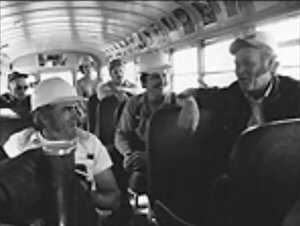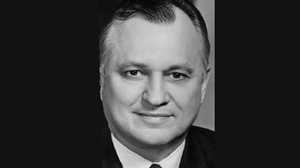How the Pipeline Transformed Life in Alaska

"Suddenly people started coming in to town. It happened kind of rapidly when it took off. Because I don't think anybody really believed this monstrous project was going to impact us. I mean, maybe the politicians did, but I think the average guy was just kind of going, 'Oh sure, we've heard this before,' because this has always been a boom or bust town. And suddenly, there it was." —J. B. Carnahan, former police officer, Fairbanks, Alaska
Influx of People and Cash
There were only two police officers patrolling Fairbanks when the Trans-Alaskan pipeline project arrived on the scene. J. B. Carnahan was one of them. Then, almost overnight, the sleepy town of Fairbanks became a boomtown. Not since Gold Rush days had the inhabitants seen so much activity. All of sudden Fairbanks was filled with a lot people with a lot of cash to burn.
J. B. Carnahan: "It was like a circus every night. People coming in to town with $3,000, $4,000, $5,000 cash in their pockets. Suddenly women that we'd never seen before were appearing from places like Florida and New York. It was like night and day."
"I Had to Be a Part of It"
People were coming up from the lower 48 states. They would drive up through Canada on the Alaska Highways. Welders and truckers came from Oklahoma and Texas. Secretaries, teachers, cooks, not to mention prostitutes and pimps, came looking for opportunities and money. Laborers from South America and Ireland also came. By 1976 Fairbanks had doubled in size, to 40,000 people. Rents quadrupled. Many who had no connection to the local unions had to wait months to get a job. Al Fleming was a father of four living on a schoolteacher's salary in Utah when he read about the pipeline.
Al Fleming: "We qualified for food stamps. We could make it, but just marginally. And then suddenly here was this job where they paid huge amounts of money. I just knew I had to be a part of it."
Complex Logistics
In October 1977 the Trans-Alaska pipeline project was fully staffed with 28,062 workers and contractors. In the three years it took to build the pipeline, more than 70,000 people were employed in one way or another. Organizing all those people was perhaps the most difficult job on the pipeline.
Engineer Bill Howitt: "The biggest thing was the logistics. Getting all that stuff and the materials and the ability to sustain 10,000 people working in a place where no one has worked before. And there was no infrastructure -- that was the big deal."
Camp Life
Many workers lived in one of 20 camps that were set up along the pipeline route. The pipeline camps ranged from 250-person sites at the pump stations to the enormous 3,500-person terminal camp at Valdez. What most people remember about the camps is the abundance of food, the partying, the alcohol and drugs.
Larry Houle: "There was not a police officer to be seen anywhere, and there was nobody that really kept order in the camp. It was pretty self-governing, I think as far as social life and what you did off the job site."
Al Fleming: "It was like Mother Goose Land, Fairyland, Disneyland all rolled into one. It was all-you-can-eat all the time. If you wanted breakfast, you could have a five course meal and for supper you could have even more."
Diane Benson: "We used to joke around that you could tell what union somebody belonged to by what drug of choice they had. I mean it seemed like operators were drunks or the Teamsters were the coke freaks and the laborers were the potheads."






